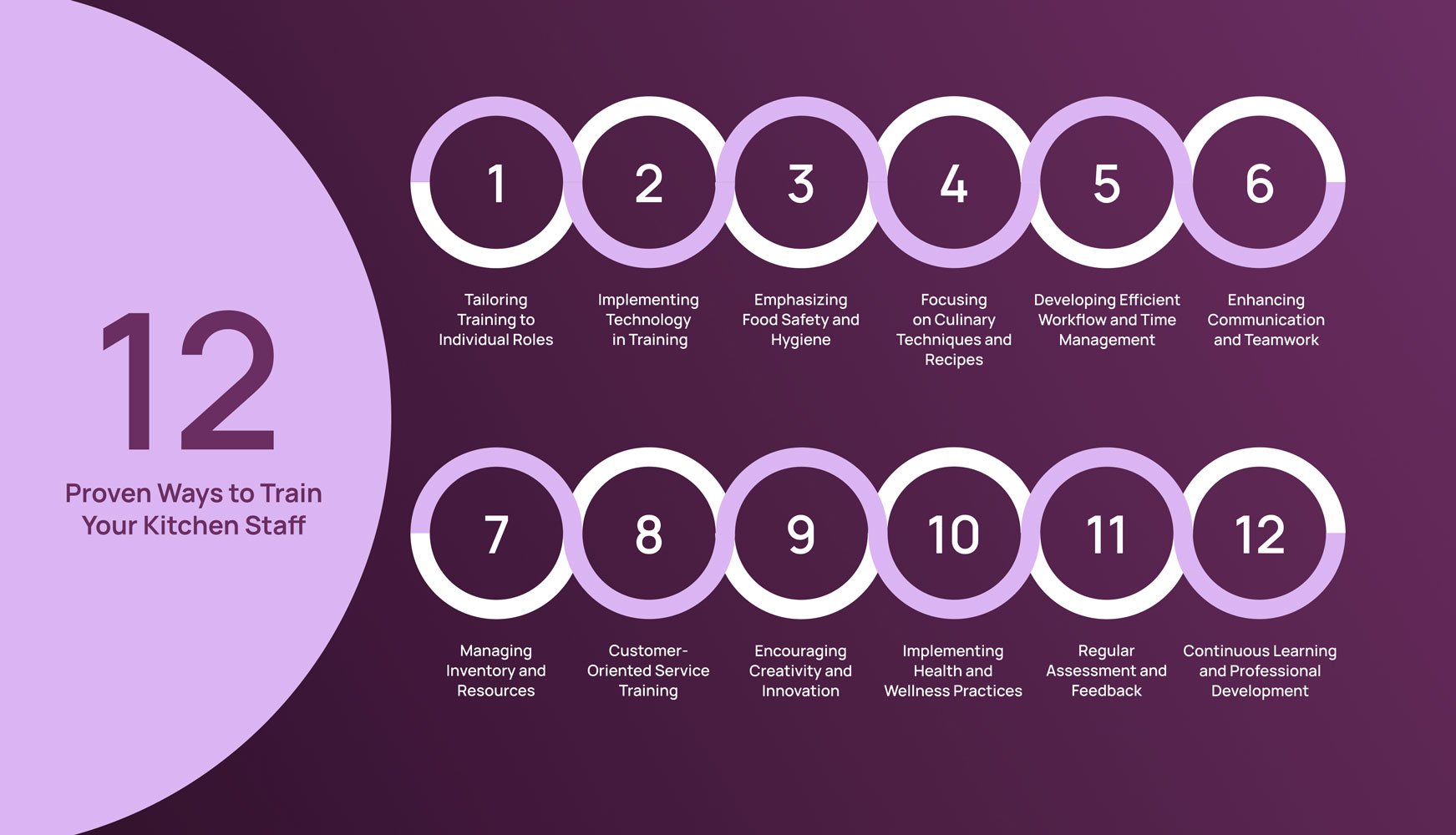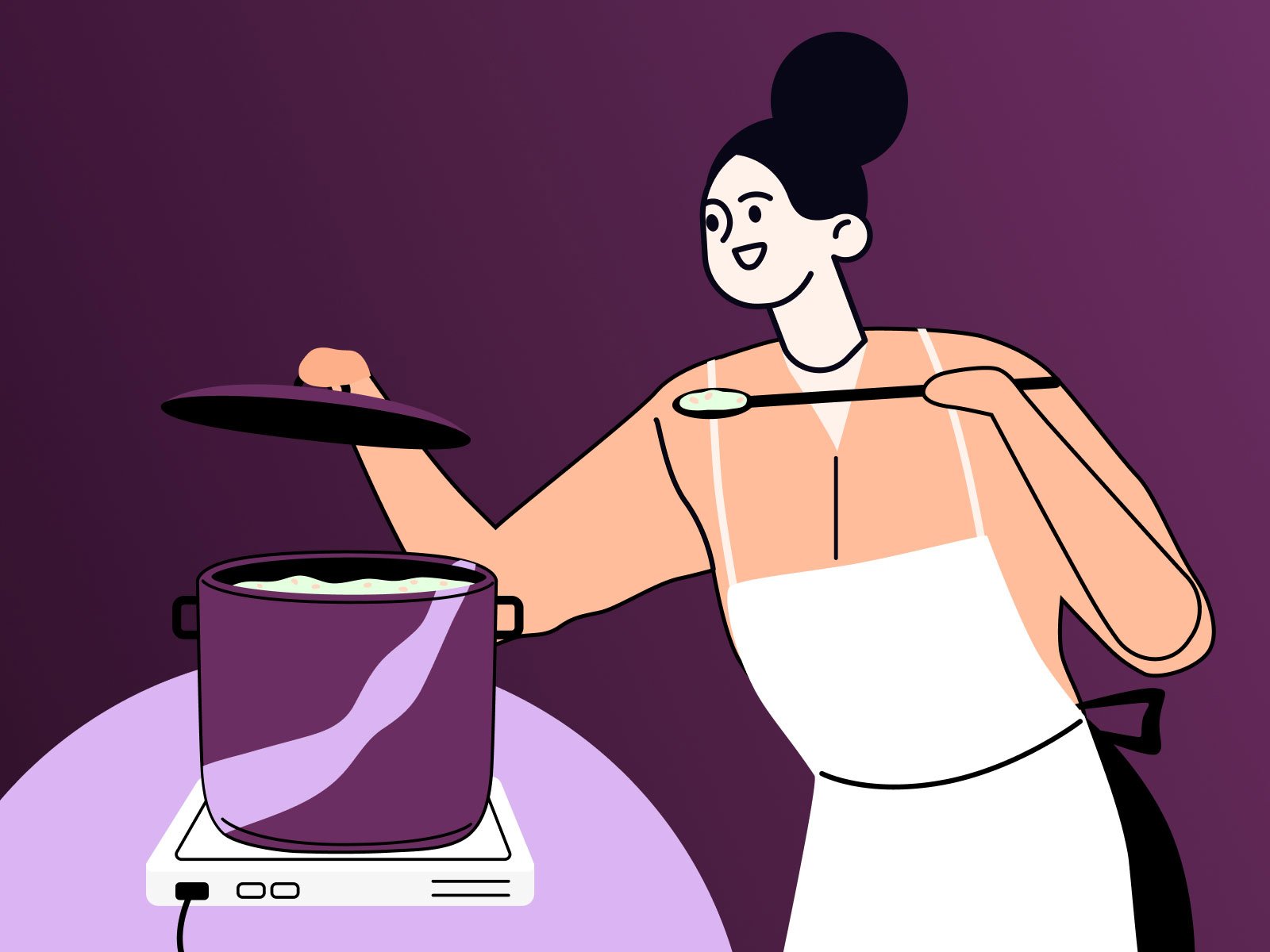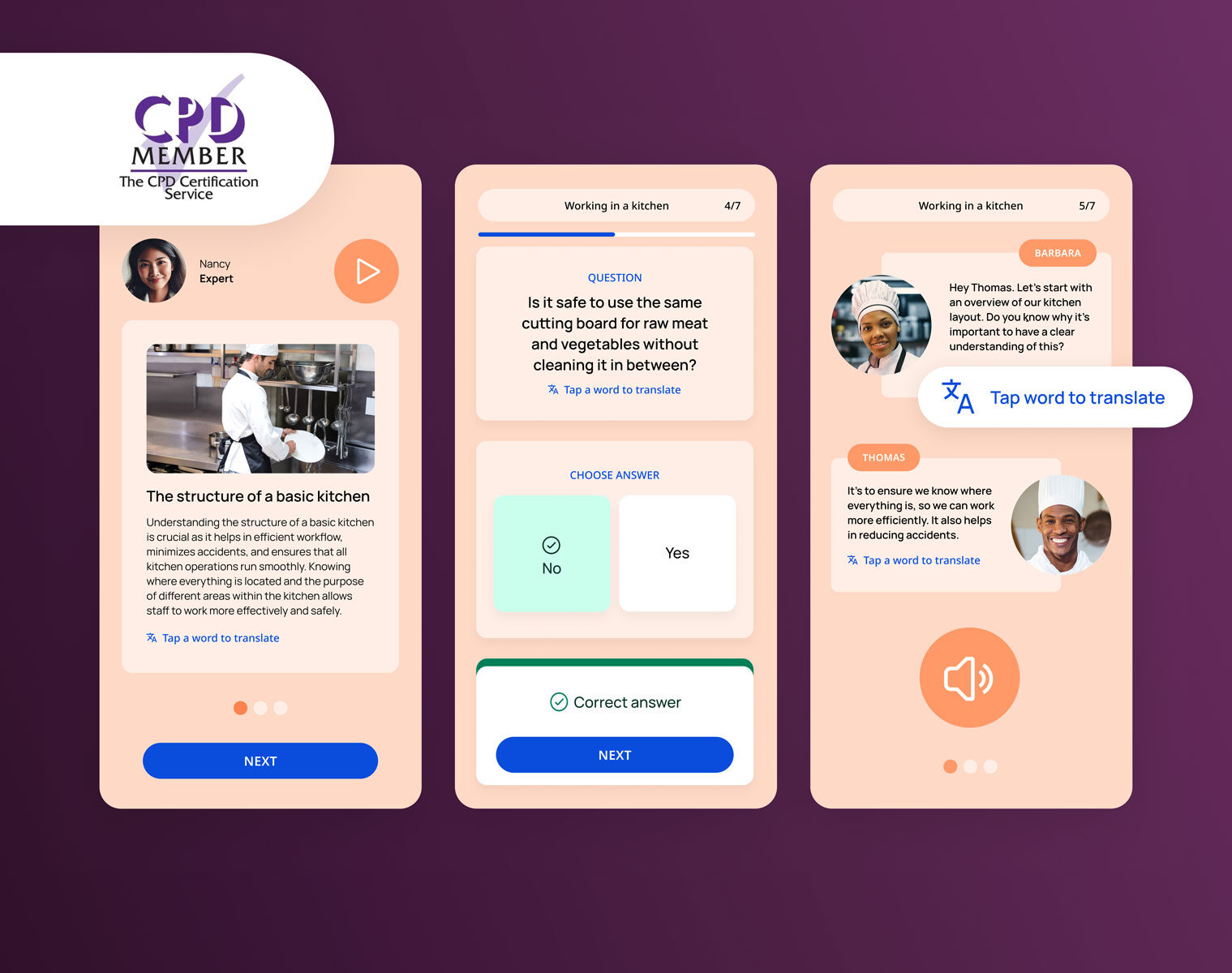12 Proven Ways to Train Your Kitchen Staff
Embarking on a journey to elevate your kitchen's performance? Here are 12 proven strategies to effectively train your kitchen staff, ensuring they are skilled, efficient, and ready to excel.

Way 1: Tailoring Training to Individual Roles
Each member of your kitchen staff plays a unique role in the overall functioning of the kitchen. By customizing the training plan based on their responsibilities, you can provide targeted and relevant instruction to enhance their performance.
For example, line cooks may benefit from training on efficient cooking techniques and recipe execution. This could include teaching them how to properly manage their time in the kitchen, and ensuring they can prepare dishes quickly and consistently without sacrificing quality.
Additionally, line cooks may benefit from learning about different cooking methods and adapting recipes to meet dietary restrictions or preferences. On the other hand, prep cooks may require training on proper food handling and storage procedures. This could involve teaching them about the importance of maintaining cleanliness and hygiene in the kitchen, as well as the correct methods for storing and labeling ingredients to prevent cross-contamination. Prep cooks may also benefit from learning about portion control and how to accurately measure ingredients, ensuring that each dish is prepared with precision.
By addressing the specific needs of each role, you create a cohesive team that can work together seamlessly to deliver exceptional results. When each member of your kitchen staff is equipped with the necessary skills and knowledge for their role, they can collaborate effectively, communicate efficiently, and ultimately produce high-quality dishes that exceed customer expectations.
Way 2: Implementing Technology in Training
In today's digital age, technology plays a crucial role in various industries, and the culinary world is no exception. Integrating technology into your restaurant staff training plan or program can enhance the learning experience and make it more engaging for your kitchen staff.
Consider using interactive training modules, online tutorials, and virtual reality simulations to teach culinary techniques and kitchen equipment operation. These innovative methods not only capture the attention of your staff but also provide a hands-on learning experience that is highly effective.
Interactive training modules are a great way to introduce new concepts and skills to your kitchen staff. These modules can be accessed through a computer or tablet and allow your staff to interact with the content. For example, you can create modules that teach knife skills, where your staff can practice their cutting techniques virtually. This not only helps them improve their skills but also allows them to learn at their own pace.
Online tutorials are another valuable tool for culinary and restaurant employee training program. With the vast amount of information available on the internet, your staff can access tutorials on various cooking techniques, recipes, and even food safety practices. By incorporating these tutorials into your training program, you provide your staff with a wealth of knowledge that they can refer to at any time. This not only enhances their learning experience but also encourages independent learning and self-improvement. And all these online tutorials and courses can be easily created with AI course creation tools like Lingio

Way 3: Emphasizing Food Safety and Hygiene
Ensuring food safety and maintaining proper hygiene practices is of utmost importance when working in a kitchen. Make sure to include comprehensive training on food handling, storage, and sanitation protocols.
Creating a culture of cleanliness and adherence to food safety guidelines will not only protect your customers from potential health risks but also instil confidence in your kitchen staff.
Food safety and hygiene are critical aspects of running a successful kitchen. By prioritising these factors, you can ensure that your establishment meets and exceeds your customers' expectations.
One way to emphasise food safety is by implementing a Hazard Analysis and Critical Control Points (HACCP) system. This internationally recognised system helps identify potential hazards in the food production process and establish control measures to prevent them. Training your staff on the principles of HACCP will enable them to identify and mitigate risks, ensuring that the food served is safe for consumption.
In addition to HACCP, training your staff on proper food handling techniques is essential. This includes teaching them how to store, prepare, and serve food safely. You can minimise the risk of foodborne illnesses by following reasonable procedures, such as using separate cutting boards for raw and cooked foods, regularly sanitising kitchen surfaces, and maintaining proper refrigeration temperatures.
Furthermore, maintaining personal hygiene is crucial for all kitchen staff. This includes regular handwashing, wearing clean uniforms, and tying back hair to prevent contamination. By enforcing these practices, you can create a culture of cleanliness and professionalism in your kitchen.
Regular inspections and audits can also help ensure that food safety and hygiene standards are being met. These inspections can be conducted by internal staff or external agencies, such as health departments or third-party auditors. By regularly assessing your kitchen's practices, you can identify areas for improvement and take corrective actions to maintain high standards.
Lastly, keeping your staff updated on the latest food safety regulations and best practices is important. This can be done through ongoing training sessions, workshops, or online courses. By investing in your staff's continuous training manual education, you can stay ahead of industry trends and ensure that your kitchen operates at the highest level of food safety and hygiene.
Way 4: Focusing on Culinary Techniques and Recipes
One of the primary responsibilities of your kitchen staff is to prepare and cook delicious meals. To ensure consistent quality, it is essential to provide thorough training on culinary techniques and recipes to restaurant employees.
Consider organizing workshops or cooking demonstrations where experienced chefs can share their expertise. This not only provides an opportunity for your kitchen staff to learn new techniques but also allows them to interact with professionals in the field, gaining valuable insights and inspiration.
During these workshops, encourage your kitchen staff to experiment with different flavors and ingredients. By fostering creativity and an appreciation for culinary craftsmanship, you empower your team to think outside the box and create unique and exciting dishes.
Furthermore, implementing a mentorship program can be highly beneficial. Pairing experienced chefs with junior staff members allows for hands-on learning and personalized guidance. This mentorship dynamic not only helps in honing culinary skills but also fosters a sense of camaraderie and teamwork within the kitchen.
Another way to enhance your restaurant staff training it's culinary expertise is by organizing regular tastings and menu development sessions. These sessions provide an opportunity for your kitchen staff to collaborate and experiment with new recipes. By involving them in the menu development process, you empower your team to take ownership of their work and contribute their ideas.
Additionally, investing in culinary training programs and certifications can be highly beneficial for your restaurant employee training and kitchen staff's professional growth. Encourage your team to attend workshops, enroll in cooking classes, or pursue certifications in specialized areas such as pastry making or international cuisine. These programs not only enhance their skills but also boost their confidence and credibility as culinary professionals.
Lastly, consider creating a recipe repository or a shared database where your kitchen staff can access a wide range of recipes. This resource can serve as a reference point for them to explore new dishes, experiment with different cooking techniques, and continuously expand their culinary knowledge.
Way 5: Developing Efficient Workflow and Time Management
In a bustling kitchen, time management is crucial for smooth operations. Teaching your kitchen staff how to prioritize tasks, work efficiently, and manage their time effectively is essential for productivity.
Introduce them to tools such as checklists, timers, and kitchen management software to optimize their workflow. By streamlining processes and improving efficiency, you can minimize delays and ensure timely delivery of dishes.
Way 6: Enhancing Communication and Teamwork
A well-functioning kitchen relies heavily on effective communication and teamwork. Encourage open lines of communication and foster a positive team dynamic.
Consider organising team-building activities, such as group cooking exercises, to strengthen relationships and encourage collaboration. You cultivate a motivated and cohesive kitchen staff by promoting a supportive and inclusive environment.
Way 7: Managing Inventory and Resources
Effectively managing inventory and resources is essential for controlling costs and ensuring smooth operations. Train your kitchen staff on proper inventory management techniques, such as inventory rotation and waste reduction strategies.
Show them how to optimize ingredient usage and encourage them to identify ways to minimize waste. By making efficient use of resources, you can maximize profitability and sustainability.
Way 8: Customer-Oriented Service Training
While your kitchen staff's primary focus may be on cooking, it's crucial to train them in providing exceptional customer service as well. They are the ambassadors of your establishment, and their interactions with customers leave a lasting impression.
Ensure they understand the importance of greeting customers, addressing their inquiries, and accommodating special requests. By instilling a customer-oriented mindset, you can create memorable dining experiences for your patrons.
Way 9: Encouraging Creativity and Innovation
Every individual in your kitchen staff has unique talents and perspectives. Encourage creativity and innovation by providing opportunities for them to contribute their ideas and recipes.
Consider organising regular brainstorming sessions or hosting cooking competitions to inspire creativity and foster a sense of ownership among your kitchen staff. By embracing their creativity, you can introduce exciting new dishes to your menu and keep your customers returning for more.
Way 10: Implementing Health and Wellness Practices
In a physically demanding environment like a kitchen, prioritising your staff's health and well-being is crucial. Teach them about proper posture, stretching exercises, and self-care techniques to prevent injuries and promote overall well-being.
Consider offering wellness programs or organising activities such as yoga or meditation sessions to support their mental and physical health. Investing in their well-being creates a harmonious work environment that fosters productivity and job satisfaction.
Way 11: Regular Assessment and Feedback
Training is an ongoing process; regular assessment and feedback are crucial for continuous improvement. Implement a system to evaluate your kitchen staff's performance and provide constructive feedback.
Consider conducting regular performance reviews for new employees, where you can recognise their achievements and identify areas for improvement. Providing feedback in a supportive and constructive manner encourages growth and motivates your staff to excel.
Way 12: Continuous Learning and Professional Development
Fostering a culture of continuous learning and professional development among your kitchen staff is essential to staying ahead in the culinary industry.
Encourage them to attend workshops, culinary classes, or industry conferences to expand their knowledge and skills. By investing in their professional growth, you not only enhance their abilities but also elevate the overall competence of your kitchen staff.








